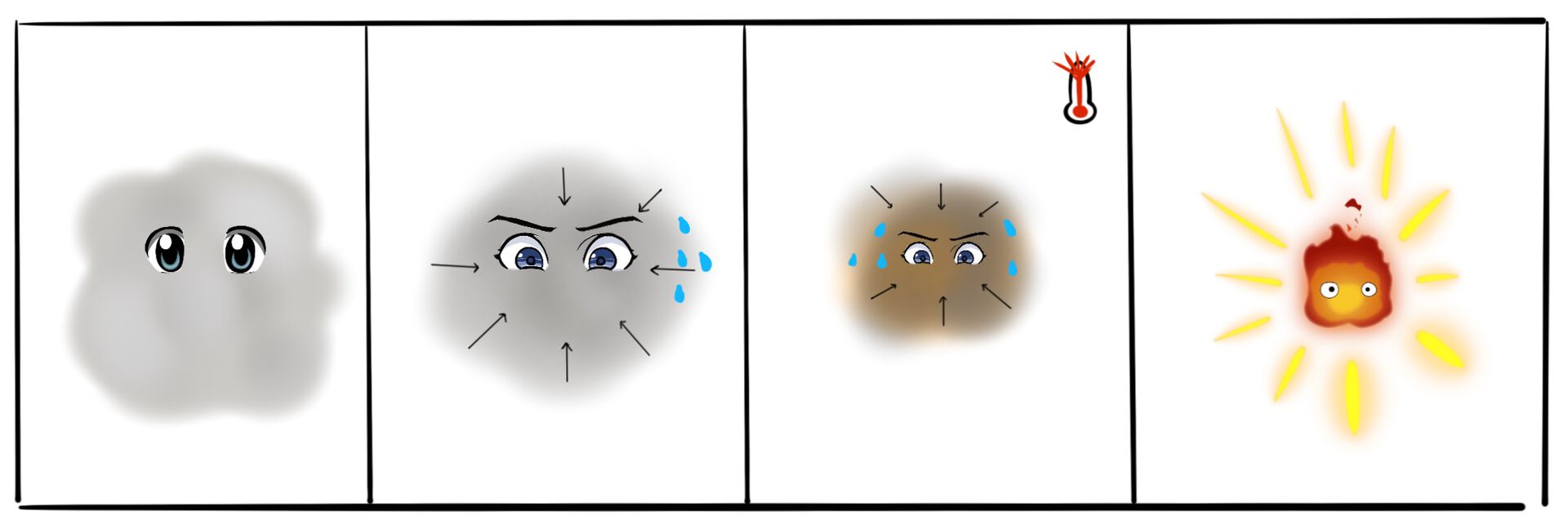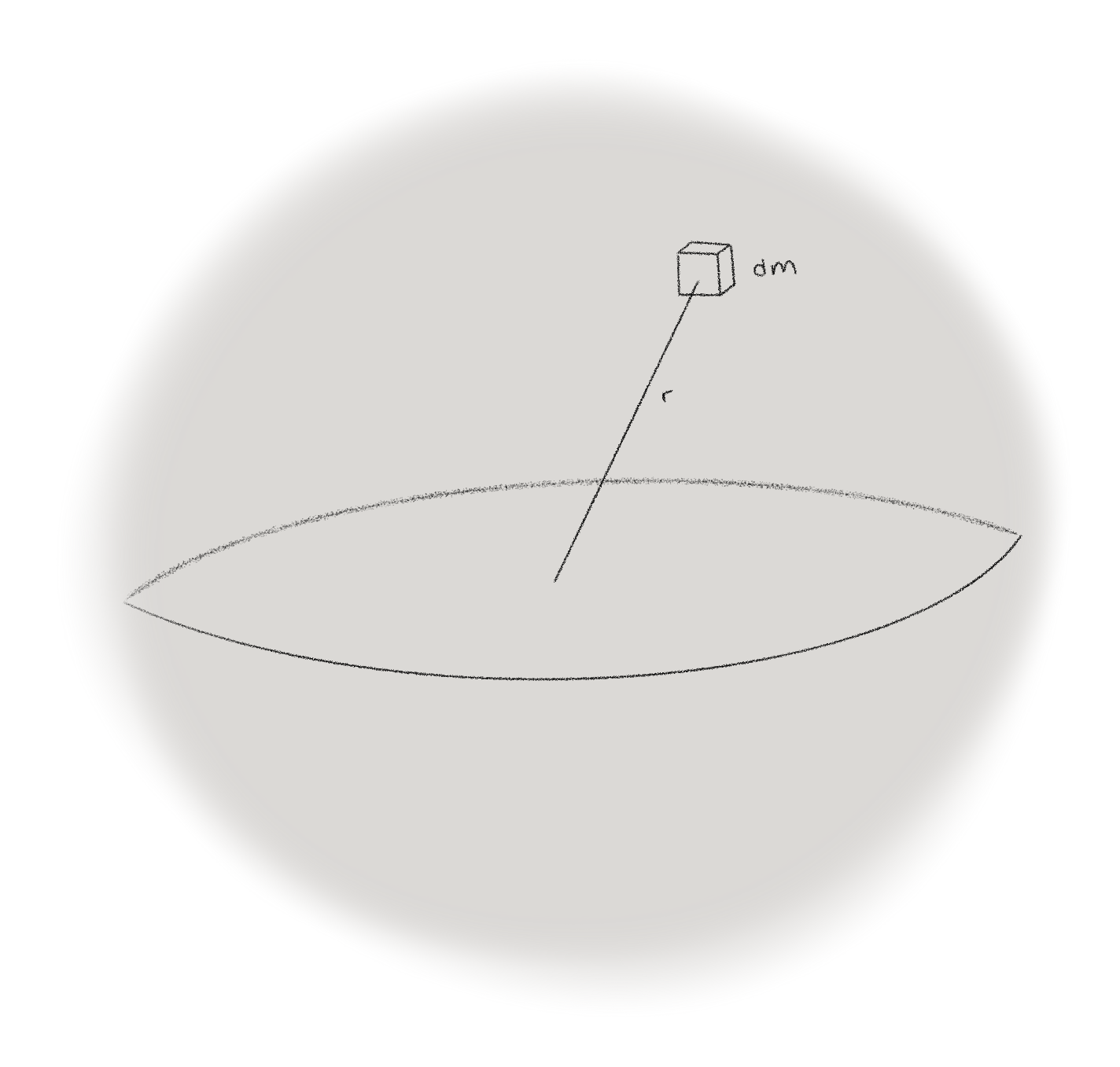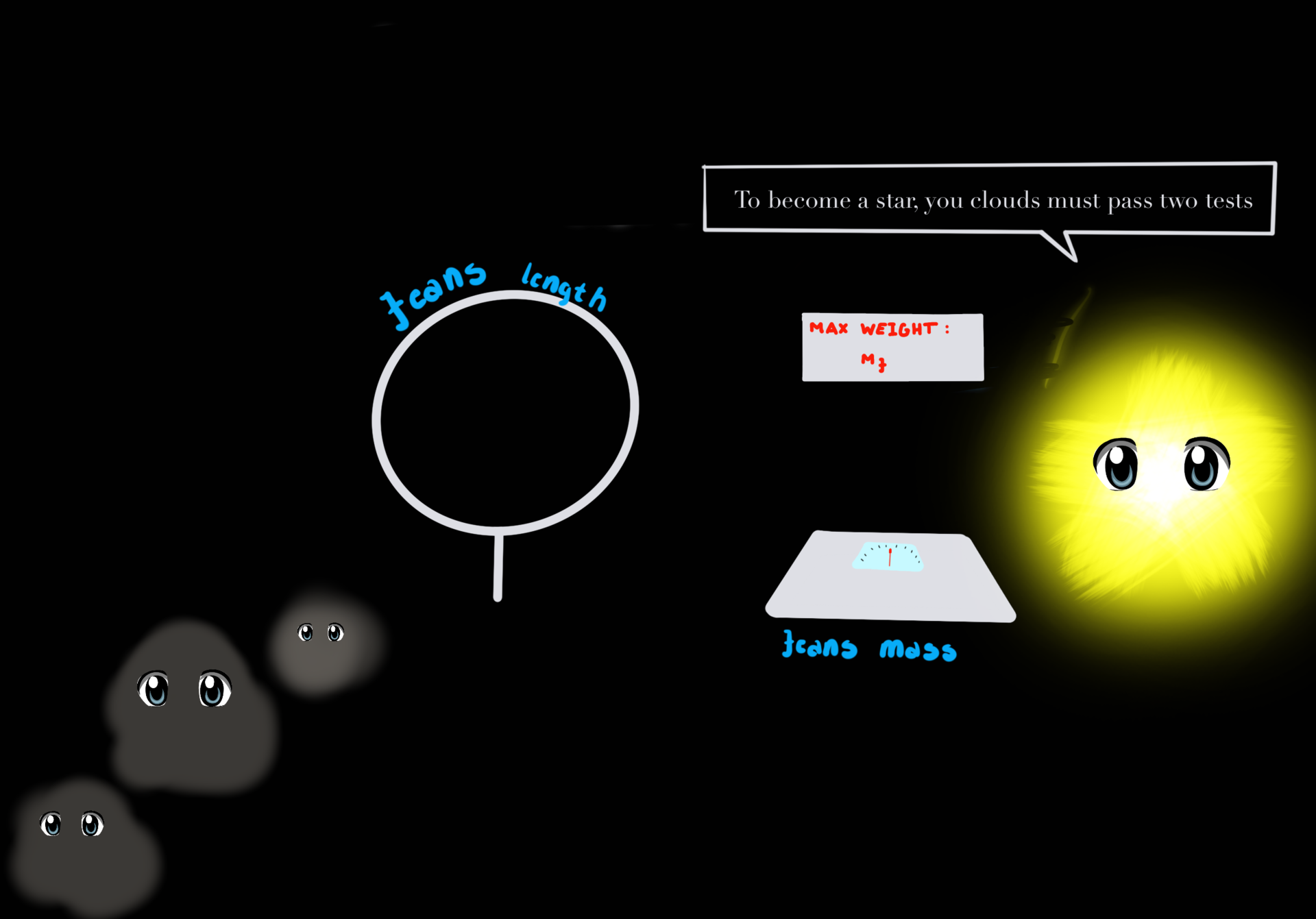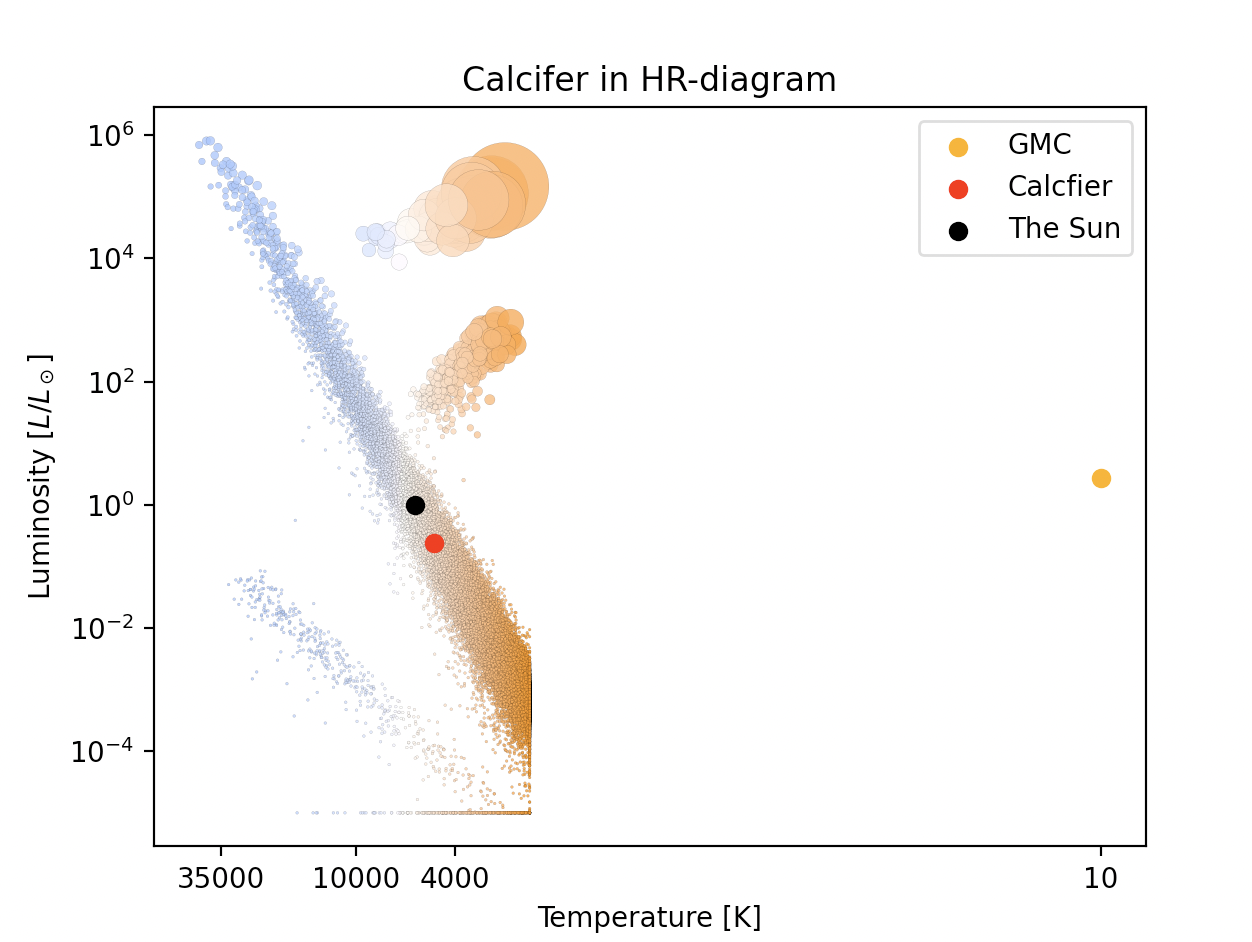Sooner or later this talk will come. The birds and bees talk regarding how a star is born. We shall take a look at Calcifer as a GMC, aka. baby Calcifer... and find what the smallest possible radius baby Calcifer could have had. Before he became the light of Camphor.
How a star is born:

- Have an accumulation of gas and dust, a cloud
- Cloud collapses due to gravity
- Radius in the cloud decreases and temperature increases
- Energy is radiated as a result of the collapse.
What did baby Calcifer look like?
Calcifer started out as a Giant Molecular Cloud (GMC) with temperature 10K (-263.15 degrees celcius) that consisted of 75% Hydrogen and 25% Helium atoms. Assume it started as a spherically symmetric GMC and began collapsing without the help of a shock wave from a supernova. Also assume the mass of the gas cloud equals the current mass of your star.
Fun fact about Giant molecular cloud
- Cold and dark
- Cannot be observed with visible light
- Also called stellar nursery
What is the smallest possible radius baby Calcifer could have had before it began its star formation?
In order to find this radius we need to introduce a theorem, The Virial Theorem. This will guide our calculations towards this radius we are looking for.
The Virial Theorem
A system in equilibrium (a stable system where all forces are balanced out to 0) obeys the virial theorem.
\(\langle K \rangle = -\frac{1}{2}\langle U \rangle\)
\(\langle K \rangle: \text{Average kinetic energy}\)
\(\langle U \rangle: \text{Average potential energy}\)
The condition for stability is therefore 2K + U = 0.
We have a statement to verify, which will hopefully answer our question to "what is the smallest possible radius of baby Calcifer?"
"As long as the cloud keeps collapsing, energy is radiated away."
Ah, so let's begin by calculating the total energy of a such cloud and apply the virial theorem to our cloud
\(E_{tot}=K + U= -\frac{1}{2}U+U = \frac{1}{2}U\) Total mechanical energy
Not only are we interested in total mechanical energy (kinetic + potential) of the cloud, but also the total potential energy. We achieve this by studying the potential energy du of a particle with mass dm and the rest of the cloud with radius r and mass M(r)
du and dm refers to infinitesimal (really fucking small) values of potential and mass.
\(du = -G\frac{M(r)dm}{r}\)
\(G: 6.67\cdot 10^{-11} \frac{Nm^2}{kg^2} \text{ (Gravitational constant) }\)

This is solved by integrating over all teeny tiny masses dm making up the cloud at a distance r from the center. Assume the mass density in the shell is given by \(\rho(r)\). Thus we end up with this expression for total potential energy
\(U = - \frac{3GM^2}{5R}\) Total potential energy
Now that we have mechanical energy and potential energy, we might as well find the kinetic energy. From thermodynamics, the kinetic energy in a gas is given by
\(K = \frac{3}{2}NkT\) Total kinetic energy
\(T: \text{ Temperature of GMC}\)
\(N = \frac{M}{\mu m_H} \text{ (Numbers of particles in the gas)}\), read about average mulecular weight \(\mu\)
Now exactly what is the relation between kinetic energy and potential energy?
The virial theorem revisited
Condition for stability is 2K + U = 0.
(When comparing kinetic energy to potential energy we need to compare 2K to U, due to the equation above)
2K > U: Gas pressure is larger than gravitational forces and the cloud expands
U > 2K: The cloud is bound by gravity and begins to collapse
Wait, let's take a look at the question we are investigating in right now. We wonder what the smallest radius baby Calcifer could have had. So our task is to find the smallest radius of the cloud before it began collapsing due to gravity and become a star. We are therefore interested in the case where
\(2K < |U|\)
which becomes:
\(\frac{3MkT}{\mu m_H} < \frac{3GM^2}{5R}\)
by inserting total kinetic energy and total potential energy deduced further up.
We can rewrite this as a criterion on the mass
\(M > \frac{5kT}{G\mu m_H}R\)
In terms of the mean density of baby Calcifer, we get
\(M_J = \left( \frac{5kT}{G\mu m_H}\right)^{\frac{3}{2}} \left( \frac{3}{4\pi\rho} \right)^{\frac{1}{2}}\) The Jeans mass
Assume the density is constant, which leads to following expression \(\text{density}, \rho = \frac{\text{mass}}{\text{volume of a sphere}}= \frac{M_{GMC}}{\frac{4}{3}\pi R_{J}^3}\)
From this we get
\(R_J = \frac{G\mu m_H M} {5kT_{GMC}}\) The Jeans length
The Jeans mass and length is a so-called critical point before the cloud will undergo a gravitational collapse. Clouds with mass above MJ and radius above RJ will begin to collapse.
Cloud radius and mass below Jeans criterium is a system in equilibrium with ability to withstand thermal pressure and gravity.
For values above Jeans, the cloud will collapse. Think of it like a bag hanging on a tree branch. The more rocks you add to the rock, the bigger and heavier the bag will be. The bag have a limit, if you surpass this limit the bag will break the branch and collapse.
Think of it like height measurement at amusement parks. Instead of height measurement, we have size and weight measurement. The clouds must be too fat for the ring and heavier than the max weight in order to become a star.

Smallest possible radius your GMC could have had: 384362809963997.06 m Luminosity of GMC: 1.052699265929842e+27 W
Back to our investigating question: What is the smallest possible radius baby Calcifer could have had?
\(\underline{\underline{\text{The answer is around }3.84\cdot10^{15}m}}\)
Say baby Calcifer is right above the minimum radius. What would the luminosity of the cloud be? And its placement in HR-diagram?

Now to the final question:
Does baby Calcifer's placement in HR-diagram make sense??
To avoid confusion in my explanations here:
Baby Calcifer = GMC
Calcifer = star
On the x-axis: Baby Calcifer had a temperature of 10K, so this looks promising.
On the y-axis: Hmmm... not quite correct. I would believe the upper limit for GMC luminosity, is the luminosity of the star himself. The reason for that; GMC is a cold cloud. Only when it begins to collapse will it radiate energy (more collapse, more luminosity). Since we are looking at the case before the GMC has begun its star formation, it must be cold and therefore have a lower luminosity than a star.
Basically the GMC should have been placed on the same horisontal line or below the star.
